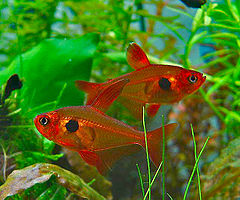Characidae
| Characidae Temporal range: Upper Miocene - Recent |
|
|---|---|
 |
|
| Red phantom tetras (Hyphessobrycon sweglesi) | |
| Scientific classification | |
| Kingdom: | Animalia |
| Phylum: | Chordata |
| Superclass: | Osteichthyes |
| Class: | Actinopterygii |
| Subclass: | Neopterygii |
| Infraclass: | Teleostei |
| Superorder: | Ostariophysi |
| Order: | Characiformes |
| Family: | Characidae |
| Subfamilies | |
|
Aphyocharacinae |
|
Aphyocharacinae
Aphyoditeinae
Bryconinae
Characinae
Cheirodontinae
Gymnocharacinae
Heterocharacinae
Iguanodectinae
Rhoadsiinae
Salmininae
Stethaprioninae
Stevardiinae
Tetragonopterinae
and see text
Characidae, the characids or characins is a family of freshwater subtropical and tropical fish, belonging to the order Characiformes. The name "characins" is the historical one, but scientists today tend to prefer "characids" to reflect their status as a by and large monophyletic group at family rank. To arrive there, this family has undergone much systematic and taxonomic change. Among those fishes that remain in the Characidae for the time being are the tetras, comprising the very similar genera Hemigrammus and Hyphessobrycon, as well as a few related forms such as the cave and neon tetras. Fish of this family are important as food and also include popular aquarium fish species.
These fish vary in length, though many are less than 3 cm (1.2 in). The smallest species grows to a maximum length of 13 mm (0.51 in).
These fish inhabit a wide range and a variety of habitats. They originate in the Americas, ranging from southwestern Texas and Mexico through Central and South America. Many of these fish come from rivers, but, for example, the blind cave tetra even inhabits caves.
This family has undergone a large amount of systematic and taxonomic change. More recent revision has moved many former members of the family into their own related but distinct families - the pencilfishes of the genus Nannostomus are a typical example, having now been moved into the Lebiasinidae, the assorted predatory species belonging to Hoplias and Hoplerythrinus have now been moved into the Erythrinidae, and the sabre-toothed fishes of the genus Hydrolycus have been moved into the Cynodontidae. The former subfamily Alestiinae was promoted to family level (Alestiidae) and the subfamilies Crenuchinae and Characidiinae were moved to the family Crenuchidae.
...
Wikipedia
